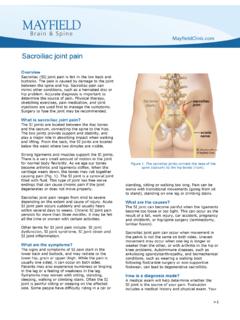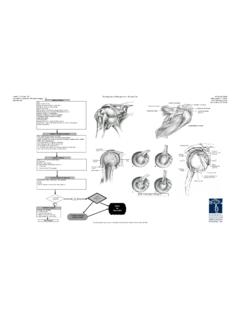Transcription of Horses And Arthritis….Facts & Treatments - H10
1 Horses And & TreatmentsThis article reviews the definition of arthritis , the signs and symptoms and then looksat the treatment of the disease particularly in the older horse offering you tips andguidelines to help you manage your of us know about arthritis , some of us even suffer from it and in general it s adisease of the aging body. Of course here we are talking about osteoarthritis ratherthan the more serious and damaging rheumatoid arthritis which can happen at anyage and is caused by many factors including immunological (from now on referred to as arthritis ) is a degenerative disease of thejoints due to factors such as wear & tear or trauma.
2 It is generally seen as a diseaseof older age and it leads to erosion and thinning of the articular cartilage, the tissuecovering on the end of joints, leading to pain and reduction of joint courtesy onset can be quite sudden in Horses as their weight bearing joints get verylittle relief and are subject to constant pressure. Indeed parts of the weight bearingcartilage can break off and irritate nearby muscles. Constant wear results in the bonesurfaces grinding on each other with the complete loss of cartilage but fortunatelycartilage can stabilise itself to some extent if some protection is be offered to thejoint and the wear and tear factor s certainly best to look for and discover the disease early in your horse sincetreatment is much more effective in the early stages.
3 Karen Hayes in her article arthritis in Horses suggests that there are 2 types of horse arthritis . The first, a lessobvious kind and the second, a very obvious the left is a diagram of a jointshowing how it is encased in a capsule .The risk of arthritis increases in yourhorse with every passing year and thatrisk can increase dependant upon thelife he has led too. If his life has beenvery physically demanding then thedisease is likely to set in earlier. Thereis a definite change in Horses aroundthe age of 15 which sees an escalationof cell death within bone, cartilage andfibrous tissue. Elasticity and the abilityto stretch decreases as does the abilityof cartilage to absorb shock due to itsthinning over Australia, PO Box 283, Lake Cathie, NSW mail: latter is obvious since the joint has been traumatised or perhaps infected and issore enough to cause lameness.
4 You call the vet. In the second type the obvioussigns are absent and there may just be a little joint puffiness which is easy to miss,meanwhile the arthritic process marches on!!Things to watch for: Slight puffiness in lower leg joints Stiff and awkward gait at start improving as the horse warms up. A reluctance to perform movements that used to be done with ease. Grating sound when the joint is used Bumps & swellings on joint extremities Stiffness after sleep or prolonged what do you look for? Inspect the joints every day feel them after mild exercise and check forany peaks and valleys in the joints. The peaks represent bones and thevalleys soft tissue areas that can be filled with fluid which you can each joint against another to see if they are symmetrical.
5 If you havea young horse, compare the joints of your older horse with these younghorse joints. Check for soundness by gently feeling the joint and probing gently. If youfind tenderness, your horse flinches, swishes his tail or shows other painreflexes it s time to call in the vet. If there s no sign of tenderness, sigh with relief! You can start some hometreatment as outlined belowa)Confine the horse in a small paddock or even a stall for a day. Keep himrelaxed and ice the affected joint. Soft, reusable chiller packs work wellwrapped in a towel. Hold the pack on for 5-6 minutes and then removefor 10 minutes and repeat 2-4 times. You can then apply a bandage toreduce further )Remove the bandage and hand walk your horse twice a day for 10-15minutes.
6 Rewrap the joint and keep him confined for a further half a )During that period take him for 2 periods of about 15 minutes of handwalking or other gentle exercise depending on how he s progressing andresponding to treatment. If the swelling, tenderness or pain returns thenyou re overdoing )Follow up the exercise with an inspection and if he s free of the originalsymptoms then you can return him to the paddock. If he isn t, best callthe steps can a horse lover take to help delay or alleviate arthritis ?It s important to be proactive and there s a whole armoury of things that can helpyour horse battle arthritisH-10 Australia, PO Box 283, Lake Cathie, NSW mail: him out of retirement.
7 Regular exercise will help if it s tailored to your horse scondition. It increases circulation, tones the muscles and it s a fact that a fit horsehas thicker and healthier cartilage covering his this in stages and start gently. Living in the pasture is ideal as the horse hasevolved to step and graze, but turning out to the paddock will also help. Anything isbetter than a stall since just the movement of walking helps the joint fluid circulationas the joint cartilage is compressed and his diet appropriate since there are supplements proven to help arthritis but it sworth checking with your vet first. We have a round up of medications etc availableat the end of this his affected joints in a passive manner by gently picking up, bending andstraightening them.
8 These passive movements are well documented as encouraginghealing in inflamed make a habit of doing stretching exercises with your horse along with a goodwarm up before exercising him. This of course increases blood flow and warms upand softens muscles and medication wisely and safely to keep your horse pain free. There are manyoptions and combinations of both conventional and alternative therapies you can Treatments are taken from Equus magazine plus other sources and are meantas information only . A vet should be consulted before the use of any medicine: Anti inflammatory medications. There are many and their principal action is to decrease the swelling, inflammation and hence the pain of arthritis .
9 Injections of hyaluran into the joints can help by improving the quality of the synovial fluid that surrounds and lubricates it. Systemic injections of this substance or polysuphated glycosaminoglycans may stimulate joint fluid quality. An injection of a steroid into the joint brings a halt to inflammation but whilst short acting steroids are fairly safe, long term usage has associated problems. Cutting edge Treatments include the use of proteins known as interleukin receptor antagonists that can stop joint degeneration as well as the use of growth factors to stimulate cartilage regeneration Nutritional supplements.
10 Examples are chondroitin sulphate and glucosamine and they are now proved to help in cartilage protection and repair. As supplements they can help prevent and/or treat arthritis . Alternative therapies (..and there are many), include for instance the use of herbs, bee venom therapy, devils claw herb blend and other herbs such as bog bean, celery seed, dandelion root, white willow and yarrow ,methylsulfonylmethane Australia, PO Box 283, Lake Cathie, NSW mail: are plenty of information sources available for you to research more thoroughlyand build up your own knowledge of this disease and its age, our Horses age too and arthritis is common to us both but with some realattention and care for our favourite animals, we can make the discomfort of arthritismuch easier to live June 2006 and adapted from several sources.






